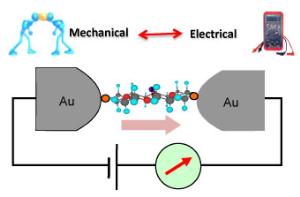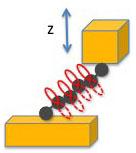
|
When electrical devices are shrunk to a molecular scale, both electrical and mechanical properties of a given molecule become critical. Specific properties may be exploited, depending on the needs of the application. Here, a single molecule is attached at either end to a pair of gold electrodes, forming an electrical circuit, whose current can be measured.
[Credit: The Biodesign Institute] |

|
Atoms of a molecule (gray) are shown, with their accompanying pi orbitals (red). As the distance between electrodes is decreased, the pi orbitals can interact with the electron orbitals contained in the gold electrodes—a process known as lateral coupling. This effect increases electrical conductance through the molecule.
[Credit: The Biodesign Institute] |
”Some molecules have unusual electromechanical properties, which are unlike silicon-based materials. A molecule can also recognize other molecules via specific interactions.” These unique properties can offer tremendous functional flexibility to designers of nanoscale devices.
In the current research, Tao examines the electromechanical properties of single molecules sandwiched between conducting electrodes. When a voltage is applied, a resulting flow of current can be measured. A particular type of molecule, known as pentaphenylene, was used and its electrical conductance examined.
Tao’s group was able to vary the conductance by as much as an order of magnitude, simply by changing the orientation of the molecule with respect to the electrode surfaces. Specifically, the molecule’s tilt angle was altered, with conductance rising as the distance separating the electrodes decreased, and reaching a maximum when the molecule was poised between the electrodes at 90 degrees.
The reason for the dramatic fluctuation in conductance has to do with the so-called pi orbitals of the electrons making up the molecules, and their interaction with electron orbitals in the attached electrodes. As Tao notes, pi orbitals may be thought of as electron clouds, protruding perpendicularly from either side of the plane of the molecule. When the tilt angle of a molecule trapped between two electrodes is altered, these pi orbitals can come in contact and blend with electron orbitals contained in the gold electrode - a process known as lateral coupling. This lateral coupling of orbitals has the effect of increasing conductance.
In the case of the pentaphenylene molecule, the lateral coupling effect was pronounced, with conductance levels increasing up to 10 times as the lateral coupling of orbitals came into greater play. In contrast, the tetraphenyl molecule used as a control for the experiments did not exhibit lateral coupling and conductance values remained constant, regardless of the tilt angle applied to the molecule. Tao says that molecules can now be designed to either exploit or minimize lateral coupling effects of orbitals, thereby permitting the fine-tuning of conductance properties, based on an application’s specific requirements.
A further self-check on the conductance results was carried out using a modulation method. Here, the molecule’s position was jiggled in 3 spatial directions and the conductance values observed. Only when these rapid perturbations specifically changed the tilt angle of the molecule relative to the electrode were conductance values altered, indicating that lateral coupling of electron orbitals was indeed responsible for the effect. Tao also suggests that this modulation technique may be broadly applied as a new method for evaluating conductance changes in molecular-scale systems.
The research was supported by the Department of Energy-Basic Energy Science program.
In addition to directing the Biodesign Institute’s Center for Bioelectronics and Biosensors, Tao is a professor in the School of Electrical, Computer, and Energy Engineering, at ASU’s Ira A. Fulton Schools of Engineering, and an affiliated professor of chemistry and biochemistry, physics and material engineering.
[Written by: Richard Harth]



